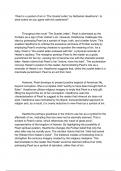Essay
Essay- Pearl as a Symbol of Sin in “The Scarlet Letter”
- Course
- Institution
- Book
“Pearl is a symbol of sin in ‘The Scarlet Letter’ by Nathaniel Hawthorne”- to what extent do you agree with this statement? This is an essay for A Level English Literature, which received an A. As well as a clean, typed version I have included an annotated copy with feedback. Additionall...
[Show more]



